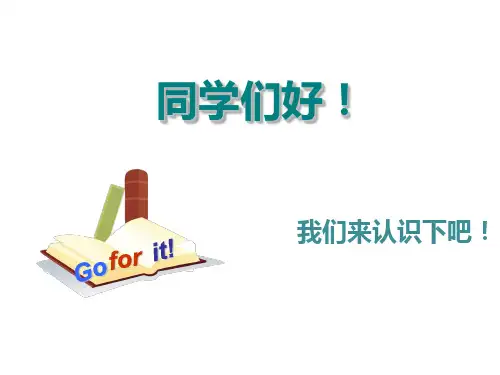初二英语第一节课课件教案资料
- 格式:ppt
- 大小:1.09 MB
- 文档页数:15
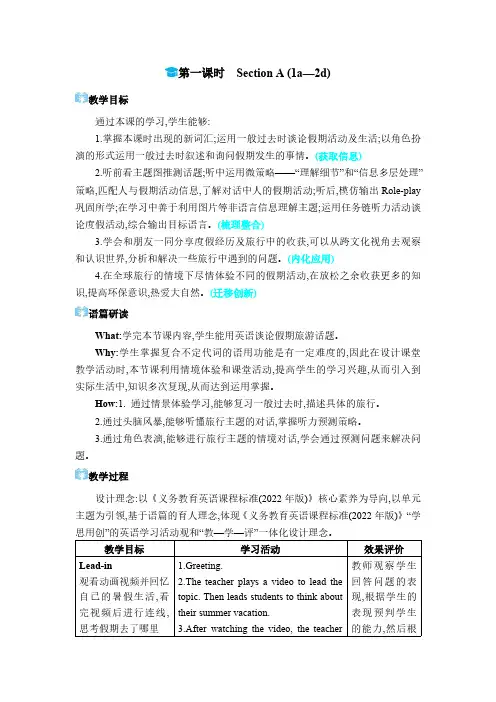
第一课时Section A (1a—2d)教学目标通过本课的学习,学生能够:1.掌握本课时出现的新词汇;运用一般过去时谈论假期活动及生活;以角色扮演的形式运用一般过去时叙述和询问假期发生的事情。
(获取信息)2.听前看主题图推测话题;听中运用微策略——“理解细节”和“信息多层处理”策略,匹配人与假期活动信息,了解对话中人的假期活动;听后,模仿输出Role-play 巩固所学;在学习中善于利用图片等非语言信息理解主题;运用任务链听力活动谈论度假活动,综合输出目标语言。
(梳理整合)3.学会和朋友一同分享度假经历及旅行中的收获,可以从跨文化视角去观察和认识世界,分析和解决一些旅行中遇到的问题。
(内化应用)4.在全球旅行的情境下尽情体验不同的假期活动,在放松之余收获更多的知识,提高环保意识,热爱大自然。
(迁移创新)语篇研读What:学完本节课内容,学生能用英语谈论假期旅游话题。
Why:学生掌握复合不定代词的语用功能是有一定难度的,因此在设计课堂教学活动时,本节课利用情境体验和课堂活动,提高学生的学习兴趣,从而引入到实际生活中,知识多次复现,从而达到运用掌握。
How:1.通过情景体验学习,能够复习一般过去时,描述具体的旅行。
2.通过头脑风暴,能够听懂旅行主题的对话,掌握听力预测策略。
3.通过角色表演,能够进行旅行主题的情境对话,学会通过预测问题来解决问题。
教学过程设计理念:以《义务教育英语课程标准(2022年版)》核心素养为导向,以单元主题为引领,基于语篇的育人理念,体现《义务教育英语课程标准(2022年版)》“学思用创”的英语学习活动观和“教—学—评”一体化设计理念。
教学目标学习活动效果评价Lead-in观看动画视频并回忆自己的暑假生活,看完视频后进行连线,思考假期去了哪里1.Greeting.2.The teacher plays a video to lead thetopic.Then leads students to think abouttheir summer vacation.3.After watching the video,the teacher教师观察学生回答问题的表现,根据学生的表现预判学生的能力,然后根asks students to match the activities with the people.4.The teacher asks students to think and answer:Where did you go on vacation?据学生的回答情况对其给予帮助和鼓励设计意图利用视频,引出本课主题,引导学生思考并头脑风暴,在思考的过程中自然地感知目标语言,激发学生学习兴趣【学习理解】Activity1:Warm up 教师带领学生一起学习新词组,同时复习动词过去式,完成书本1a部分任务1.The teacher teaches the new phrasesand asks students to do some exercise.Then practice the sentence structures.2.Review the past tense of verbs.3.The teacher asks students to finish thetask in1a on page1.教师观察学生回答问题的表现,根据学生的表现预判学生的能力并了解学生的已知内容设计意图听前将新单词和句型进行操练,为听力训练降低难度;将句型融入单词教学中,有助于应用;书本任务有利于学生更好地掌握词汇和句型的用法【学习理解】Activity2: Listening practice 通过完成不同层次的听力活动,根据1a部分的图片,与同桌进行角色扮演,然后自行创编对话1.The teacher asks students to finish thetask in1b and1c on page1.2.Work in groups and practice the conversation.A:Can you come to my party on Sunday afternoon?B:Sure,I’d love to.C:Sorry,I can’t.I have to prepare for anexam.D:I’m sorry,too.I must go to thedoctor.教师观察学生能否按要求完成听力任务,同时设法调动学生的积极性,提高学生的听力水平设计意图通过听力策略的教授,帮助学生更好地把握听力侧重点;将听力文本拆解,便于学生巩固目标词汇和重点句型【学习理解】Activity3: Listening practice 通过完成不同层次的听力活动,输入新的词汇及句型,提高学1.The teacher asks students to finish thetask in2a and2b on page2.2.The teacher asks students to listen tothe conversations and fill in the blanks.3.The teacher asks students to listen and教师观察学生能否听取语篇大意和细节信息,并观察学生对动词词组的生获取关键信息的能力repeat.掌握情况设计意图听前先带领学生熟悉图片内容和听力方向,为听力找寻关键词,跟读录音模仿并角色扮演,培养学生的口语能力和应用能力【学习理解】Activity4:Pair work 运用所学目标语言进行两人对话,让学生对文本内容进行深度解析1.The teacher asks students to make conversations according to the chart andsample in pairs.2.The teacher invites some pairs to acttheir conversations out.3.The teacher asks students to make areport about the chart in groups.4.The teacher asks students to chooseone feeling to make conversations abouttheir last vacation.教师观察学生能否准确地运用目标语言,能否在有限的时间内组织对话,同时要关注这一活动是否能够培养学生的语言应用能力设计意图创造真实的语言环境,为学生的口语训练搭建平台,使学生能做到学以致用【应用实践】Activity5:Summary 教师带领学生一起进行内容总结Summarize the key contents in thislesson.教师观察学生在语境中运用核心语言进行问答和交流的情况,根据学生的表现给予指导和反馈设计意图总结本课所学内容,让学生巩固加深印象,利用思维导图给学生进行有序的梳理【学习理解】Activity6: Further thinking通过思考与回答听前和听后的提问,培养学生的发散性思维和创造性思维The teacher explains knowledge points.教师观察学生能否根据语篇的主要内容,进行深度思考和评价设计意图引导学生进行深入思考,进一步提升学生的思维品质,升华主题【迁移创新】Activity7:Groupwork运用本课主题内容启发学生进行思考,并The teacher assigns the test.教师观察学生小组讨论和总结完成任务的情况,并根据实完成任务际情况给出必要的指导和反馈设计意图让学生在课上练习知识点,及时操练重点知识和目标语言,让教师把握学情【应用实践】板书设计作业设计基础型作业:Choose different feelings and make conversations about your last vacation.实践型作业:Make a travel log.拓展型作业:Search information about Hong Kong.教学反思。
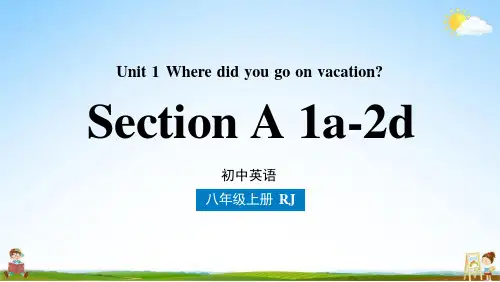
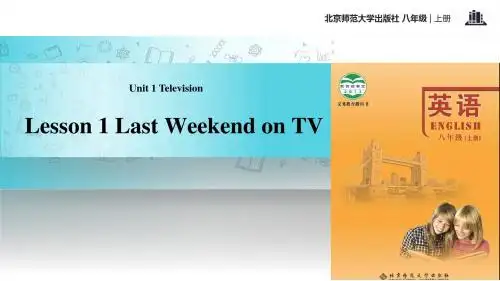
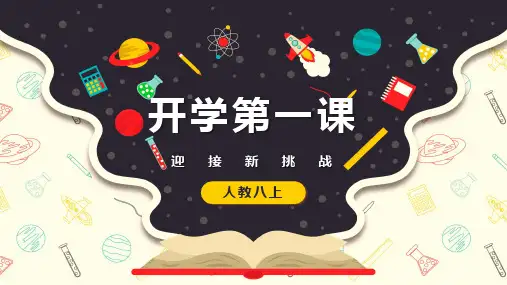
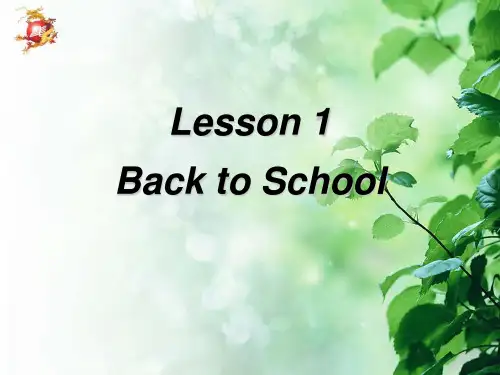
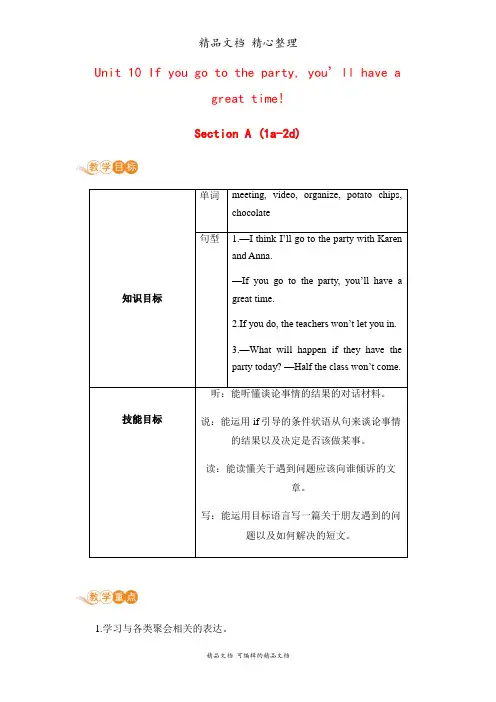
Unit 10 If you go to the party, you’ll have agreat time!Section A (1a-2d)单词meeting, video, organize, potato chips,1.学习与各类聚会相关的表达。
2.熟练运用if引导的条件状语从句。
掌握if引导的条件状语从句在日常交际中的运用。
Step 1以节奏欢快的歌曲导入新课,引起学生的学习兴趣。
以图片形式向学生呈现if条件句,为接下来的学习做准备。
1.Warming upPlay the song If you are happy to the Ss and ask them sing the song together.2.Leading inShow Ss some pictures and sentences to lead in.e.g.: She is going to walk to school. She will be late.If she walks to school, she will be late.Step 2通过展示图片帮助学生掌握新词汇。
通过图片与陈述搭配,让学生加深对目标词汇的理解。
1.New wordsShow some pictures on the PPT and teach the new words and phrases in this period:meeting, video, organize, potato chips, chocolate.2.Work on 1aAsk Ss to look at the pictures and the chart in 1a, and match the statements with the pictures \[a-d\]. Then check the answers with the class together.【Keys:1.c;3.b;4. 4.a】Step 3让学生在听的过程中掌握抓住关键词的方法。
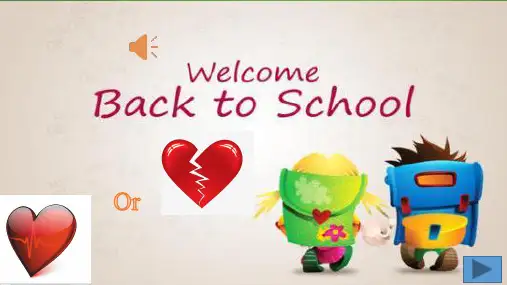
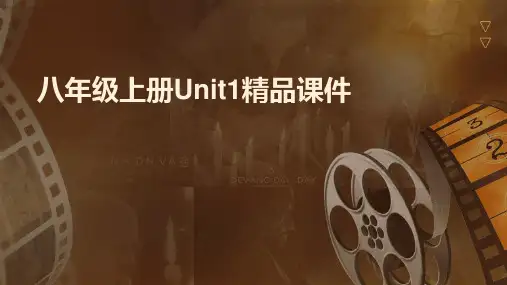
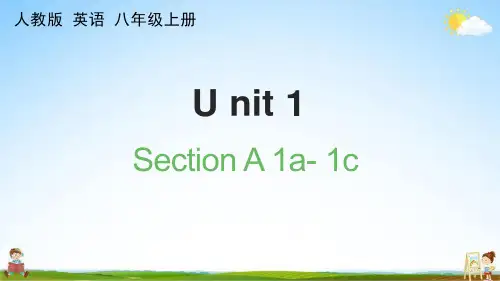
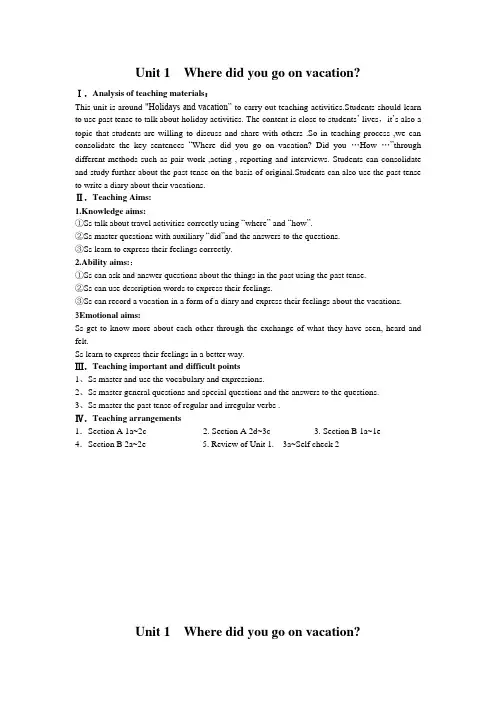
Unit 1 Where did you go on vacation?Ⅰ.Analysis of teaching materials:This unit is around "Holidays and vacation” to carry out teaching activities.Students should learn to use past tense to talk about holiday activities. The content is close to students’ lives,it’s also a topic that students are willing to discuss and share with others .So in teaching process ,we can consolidate the key sentences “Where did you go on vacation? Did you …How …”through different methods such as pair work ,acting , reporting and interviews. Students can consolidate and study further about the past tense on the basis of original.Students can also use the past tense to write a diary about their vacations.Ⅱ.Teaching Aims:1.Knowledge aims:①Ss talk about travel activities correctly using “where” and “how”.②Ss master questions with auxiliary “did”and the answers to the questions.③Ss learn to express their feelings correctly.2.Ability aims::①Ss can ask and answer questions about the things in the past using the past tense.②Ss can use description words to express their feelings.③Ss can record a vacation in a form of a diary and express their feelings about the vacations.3Emotional aims:Ss get to know more about each other through the exchange of what they have seen, heard and felt.Ss learn to express their feelings in a better way.Ⅲ.Teaching important and difficult points1、Ss master and use the vocabulary and expressions.2、Ss master general questions and special questions and the answers to the questions.3、Ss master the past tense of regular and irregular verbs .Ⅳ.Teaching arrangements1.Section A 1a~2c 2. Section A 2d~3c 3. Section B 1a~1e 4.Section B 2a~2e 5. Review of Unit 1. 3a~Self check 2Unit 1 Where did you go on vacation?Period 1 Section A 1a~2cI. Teaching Aims:1.Knowledge aims:Key words and phrases: New York City. Central Park anyone. anywhere interesting wonderful. Key sentences: Where did you go on vacation?I went to New York City.Did you buy anything special?Yes. I bought something special for my dad.2.Ability aims: Students learn to discuss their vacations in the past using key sentences.Students improve their listening and speaking skills.3. Emotional aims: Ss exchange their feelings about their vacations and know more about each other.II. Teaching important and difficult pointsSs master key words and sentences, then use them correctly.Ss learn to talk about what they did in the past.Ss improve their listening and speaking skills.Ⅲ. Teaching Aids:mufti-media, tapeUnit 1 Where did you go on vacation?Period 2 Section A 2d~3cI. Teaching Aims:1.Knowledge aims:Key words and phrases: most of the time, quite a few ,something, anything / nothing fun, everyone, of course , myself , yourself, hen, pig, seem to be bored, someone, diary, Huangguoshu Waterfall.Key sentences:Did you do anything fun on your vacation? Yes, I did. I went to ….How was your vacation? How did you like it? It was wonderful.Did you do anything interesting\buy anything special?The only problem was that there was nothing much to do in the evening but read.Still no one seemed to be bored.2.Ability aims: Ss learn to talk about their vacations using key sentences.Ss improve their speaking skills.3. Emotional aims: Ss express their feelings about vacations.II. Teaching important and difficult pointsSs get to know how to talk about their vacations using past tense.Ss understand differences between different pronouns and know how to use pronouns correctly Ⅲ. Teaching Aids: mufti-media, tapeUnit 1 Where did you go on vacation?Period 3 Section B 1a~1eI. Teaching Aims:1.Knowledge aims:Key words and phrases: Malaysia, Malaysian, Georgetown, Word Quay, Penang Hill, Key sentences: Where did she go on vacation?Did she do anything special?What did she do there?How was the food? How were the people?2. Ability aims: Ss learn to discuss their vacations including the places, the food, the people, the weather and so on. Ss improve their listening and speaking skills.3. Emotional aims: Ss share the vacations and know more about different places.II. Teaching important and difficult pointsSs master and use key words and sentences correctly.Ss improve their listening and speaking skills.Ss learn to talk more about their vacations and exchange their feelings.Ⅲ. Teaching Aids: mufti-media, tapeUnit 1 Where did you go on vacation?Period 4 Section B 2a~2eI. Teaching Aims:1.Knowledge aims:Key words and phrases: activity, decide to do, try, feel like, Paragliding, bicycle ,building, trader, wonder, difference ,top, wait for,umbrella, wet, because of , below, enough, hungry , as, hill, Key sentences: I felt like I was a bird.We saw the houses of the Chinese traders from 100 years ago.I wonder what life was like here in the past.What a difference a day makes!Because of the bad weather. We couldn’t see anything below.2. Ability aims: Ss learn to write a diary about their vacations.Ss improve their reading and writing skills.3. Emotional aims: Ss get to understand different travel experience makes people have different feelings.II. Teaching important and difficult points1. Ss master and use key words, phrases and sentences correctly.2. Ss improve their reading skills and writing skills.3. Ss learn to write a complete diary about their vacation.Ⅲ. Teaching Aids: mufti-media, tapeUnit 1 Where did you go on vacation?Period 5 3a~Self check 2I. Teaching Aims:1.Knowledge aims:key words and phrases: Tian’anmen Square, the Palace Museum ,a Beijing hutong. learn something important , Beijing duckKey sentences: Did you dislike anything?What did you like best?How did you feel about the trip?2. Ability aims: Ss talk about their vacations in the past using key sentences in this Unit.Ss improve their listening, speaking and writing skills.3. Emotional aims: Ss exchange their feelings by talking about vacations and get to know moreabout others.II. Teaching important and difficult pointsSs revise and master the key sentences and phrases in this unit.Ss improve their speaking, listening and writing skills.Ⅲ. Teaching Aids: mufti-media, tape。
